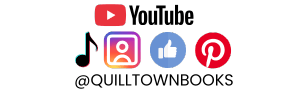Pinterest Strategy for Self-Published Authors: How I Grew Quill Town Books with Manual Pinning & SEO
Pinterest Strategy for Self-Published Authors | Quill Town Books
I didn't have a clear plan when I first started using Pinterest for my author brand. Like many authors, I juggled book launches, social media, and content creation. However, once I made a few strategic changes, my Pinterest started working for me instead of sitting in the background.
Here’s a look at my personal Pinterest strategy—what I’m doing, what I’ve learned, and how it’s helping grow Quill Town Books.
Want a free printable of my Pinterest strategy checklist? Click here to download it now


Branding First: My Pinterest Makeover
I focused on setting a strong foundation before I even touched my boards or pins. I updated my Pinterest profile banner to reflect the heart of Quill Town Books, using my brand colors and images of my published books. I included award badges on each book image to build trust and credibility.
I also updated my profile picture to match the one I use across all my social media accounts for a cohesive look. Then, I added Pinterest keywords directly into my profile: "Quill Town Books / Books and Printables for Kids". I followed this up with a keyword-rich profile description clearly explaining who I serve and what I offer.
Boards That Reflect My Brand
Once my branding was solid, I turned my attention to my boards. I currently have 13 boards, ranging from "Books to Love" to "Mindfulness Journal Prompts" and "Children's Book Merch & Teacher Gift Ideas."
Each board has:
A branded cover with my signature colors
A keyword-rich title
Pins grouped by relevance
I aim for each board to have 50–100 pins and am mindful to avoid overlapping content. While I love plants, my "Plants" board is the only one that doesn't reflect my brand (yet!).

Pin Creation: Designed With Purpose
I use Canva to design all my pins. I start with my own pictures whenever possible. If I can’t find the perfect image, I search Canva’s photo library. I vary pin sizes, mainly sticking to the Pinterest-recommended 2:3 or 9:16 formats. I’ve also started experimenting with video pins and will write about what I learn in a future post.
My pins always reflect my brand. I use my color palette (light tan, light pink, dark pink, and dark brown), include my logo, and add my website to each pin. I even add alt text in Canva by right-clicking on the image—another layer of Pinterest search power!
Manual Uploads and Scheduling
Each week, I upload seven pins to a different board and schedule them to post one daily. I make sure each pin links to a unique URL (like my blog, book page, lesson plan, or product listing). I aim to batch-create 30 pins and schedule them all simultaneously using Pinterest’s native scheduler.
I switch between "Create a Pin" and "Create an Idea Pin" formats. Idea Pins let me tag the content into relevant categories like "Reading Activities" or "Books to Read," which helps with visibility.
Keyword-Rich Titles & Descriptions
Titles and descriptions matter—a lot. I research keywords using Pinterest Trends and the Pinterest search bar. I pick 3–5 strong keywords, then use ChatGPT to help craft compelling titles and descriptions that I later refine in my voice.
Every pin I post includes:
A clear, relevant title
A description that naturally uses the keywords
A link that delivers on what the pin promises

Repurposing, Not Deleting
In spring 2025, I overhauled my Pinterest strategy. But instead of deleting my old pins, I updated them.
I revised the titles, added proper descriptions, reassigned them to better boards, and updated the destination URLs. Many of my older pins were imported automatically from Instagram and didn’t even have a URL attached. Now, they lead to my books on Amazon, lesson plans, or blog posts.
Content That Solves Problems
My content is built around my books' lessons: kindness, compassion, creativity, screen time balance, generosity, and early learning. Every pin points to something meaningful:
Social emotional learning tips
Early learning printables
DIY paper crafts for holidays
Activity books and journals
Free lesson plans for teachers
I currently pin my content and spotlight other self-published authors through book reviews.
Tracking & Growth Habits
Pinterest isn’t about instant results—it’s a long game. I check my analytics weekly, but track my performance monthly. Starting April 28, 2025, I began logging impressions, engagements, clicks, and saves.
I plan to design a Canva-based Pinterest Tracker Spreadsheet to monitor growth more easily and adjust strategy when needed.

Final Thoughts
Pinterest has become a vital tool for Quill Town Books. It’s not just for pretty pictures—it’s a search engine. With the right strategy, thoughtful pins, and consistency, it can drive organic traffic to your books, blog, and printables.
Want a free printable of my Pinterest strategy checklist? Click here to download it now.
Follow along on Pinterest @QuillTownBooks to see it in action!




